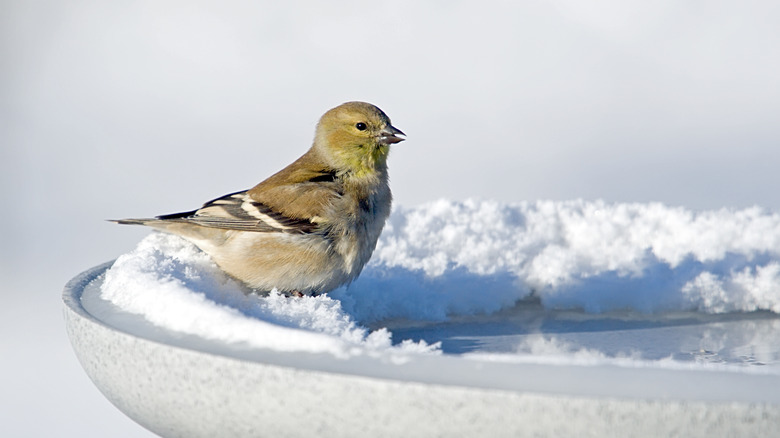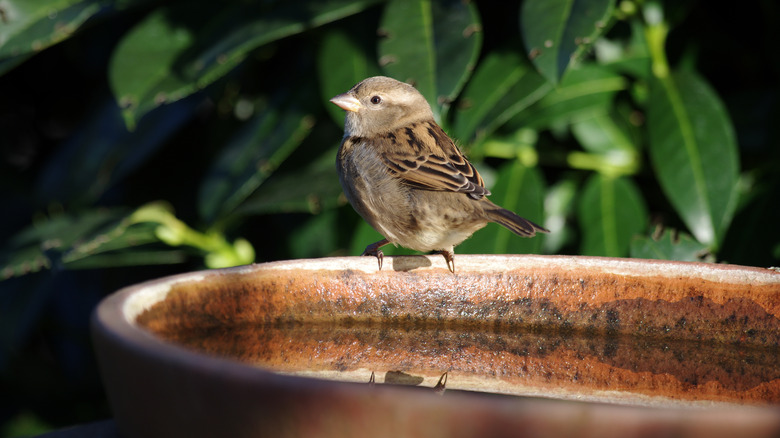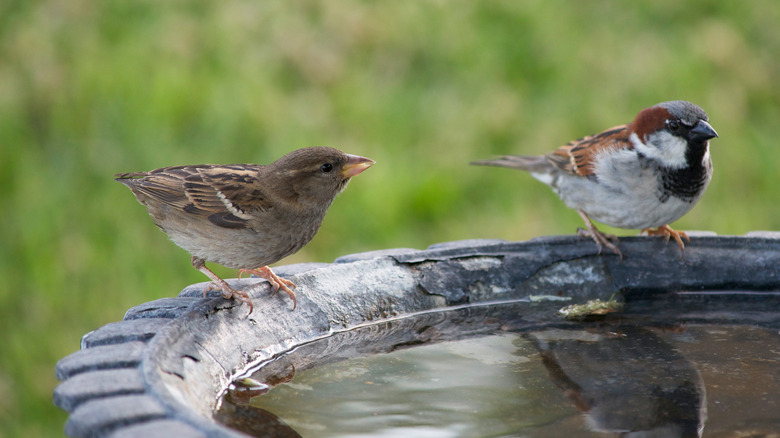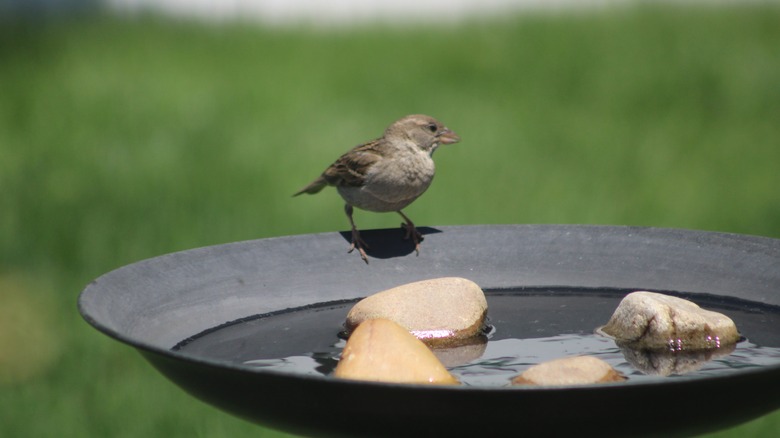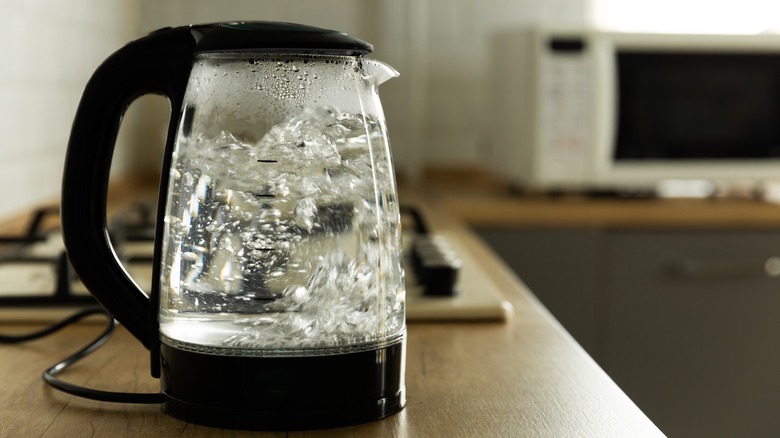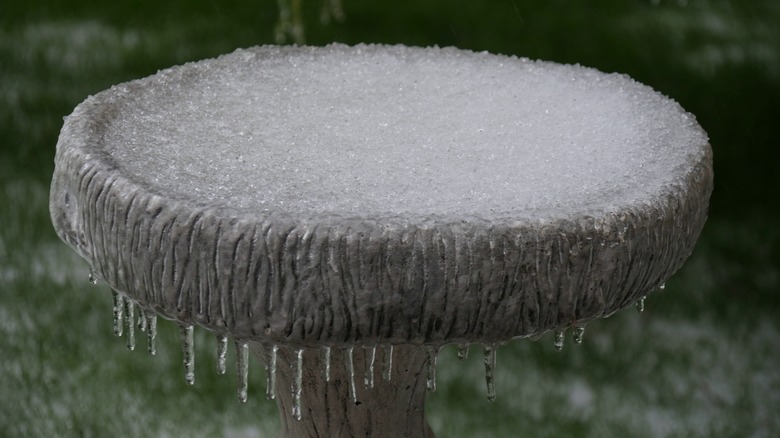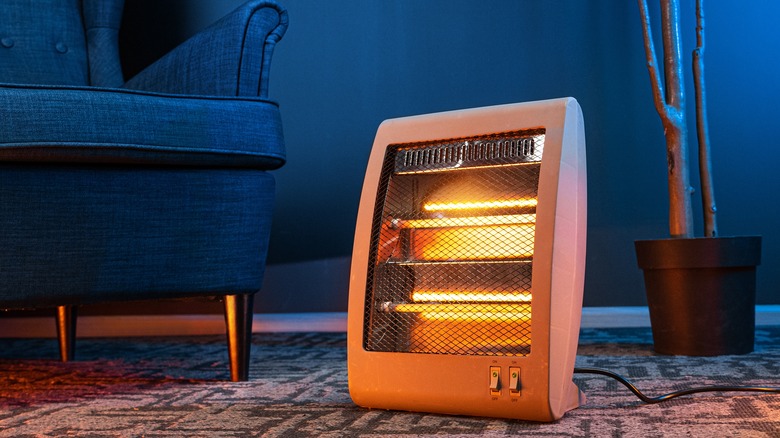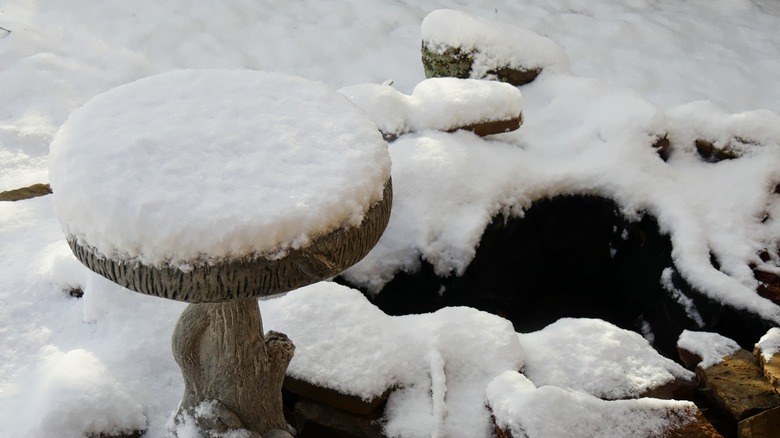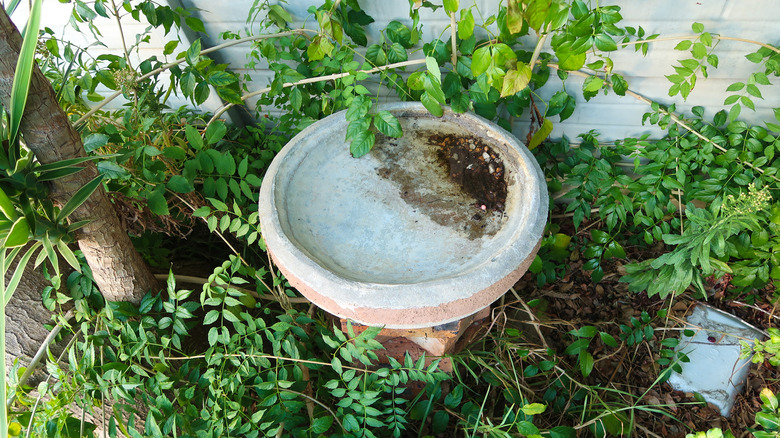8 Bird Bath Winter Maintenance Mistakes To Avoid Making At All Costs
We may receive a commission on purchases made from links.
Bird baths can help keep our feathered friends healthy and happy throughout the winter season — but only if you maintain them properly. Overwintering birds have all the same needs as your summer garden visitors — including clean drinking water — so it's worthwhile to keep your bird bath out throughout the year. There are some overwintering steps to take to keep bird populations healthy, prevent damage to your bird bath, and keep the water from freezing. Even more importantly, there are some actions to avoid (even if they might seem like a good idea at first!) to keep your bird bath both safe and usable.
Not all bird baths are suitable for winter use, particularly in areas where it goes below freezing. When water freezes, it expands, which can damage materials like ceramic, clay, glass, concrete, and stone. If your area experiences very cold winters, it's best to empty, clean, and completely dry these bird bath types. You can either store them upside down outdoors or bring them indoors. Instead, for cold climates, use resin and plastic bird baths. These are durable choices that will hold up to freezing weather. Regardless of which bird bath type you choose, there are steps you need to take before winter use. We've rounded up some of the top things you shouldn't do when preparing your bird bath for colder seasons. Keep it in tip-top shape this winter by avoiding these maintenance mistakes.
Not moving your bird bath to a sunnier spot
In areas that tend to stay above freezing, placing the bird bath in a sunny area in the winter can help make sure the water remains liquid. In freezing weather, this won't be enough, and you will need to add a heater to your bird bath, like the K&H Pet Products Super Ice Eliminator. Even if you use a bird bath heater, it helps to keep the basin in a sunny spot. Most heaters switch on when the water temperature goes below 40 degrees. Placing your bird bath in the warmest spot in your yard means the heater needs to run less frequently, using less power and causing less wear or tear on the appliance.
If you have a solar bird bath heater, a sunny location is even more important to charge it up. While solar heaters are convenient, plug-in options are more reliable, especially in the winter when there is less sunshine. If you opt for the latter, this means your bird bath also needs to be placed within reach of an outdoor outlet during the colder months. You also may need an outdoor-rated extension cord (and you'll want to make sure you set it up so it's not a tripping hazard).
Putting additives in the water
Birds are sensitive creatures, and since they use bird baths for both drinking and bathing, you need to make sure to maintain a safe environment. While it may be tempting to add something to the water to prevent it from freezing over, this isn't a good idea. Salt, chemicals, antifreeze, glycerin, or any other products should never be added to a bird bath. Even if some substances are non-toxic to humans, they can be very harmful to birds.
Some additives are harmful to birds when swallowed, while others might leave residue on their feathers that can affect their health. For this reason, only use clean, fresh water in a bird bath. Water from the tap or hose is perfectly fine! You also want to make sure to change the water often to keep it clean. However, there are a few items you can add to help it stay liquid throughout the winter, which we explore ahead.
Forgetting to add large stones, twigs, or other items to break up the ice and give birds more space to perch
There is one type of "additive" that isn't harmful: physical items and decorations. For example, large stones and twigs can help to break up the ice, while also doubling as a useful perch for visiting birds (especially if the rim of the bird bath is covered with snow). Movement can also keep the water from freezing over. A low-cost solution is to add a small plastic ball to float on the surface of your bird bath. As the ball moves about from the wind and bird activity, it can break up any thin layers of ice as they start forming. Bird bath fountains also help to keep the water moving and reduce ice build-up, while looking gorgeous as well.
Dark colors better absorb and retain heat from the sun, and in the winter, you can use this to your advantage. Consider using dark-colored accessories and decorations. For example, you can line the bottom of your bird bath with black river rocks. This can help the water stay just that little bit warmer, especially if you position your water feature in the sun.
Using boiling water to melt the ice
If a layer of ice forms over your bird bath, it can feel very tempting to pour some boiling hot water on it. While this might melt the ice, it also might break your bath. Many materials can become damaged from very hot water. Fragile bird baths can shatter or crack from the extreme temperature change from cold to hot. Sturdier plastic and resin versions aren't safe from damage either: — boiling water can warp these materials.
Mixing in a bit of warm (not hot) water is useful for melting a layer of ice, and it's a method you can try in a pinch or a cold snap. However, it's really just a temporary fix. As long as the weather is cold enough, it will keep freezing over. A better long-term solution is to invest in a bird bath heater. They're affordable and readily available at most home improvement stores.
Using excessive force to break the ice
If the ice is thin, it should be easy to break up with some gentle taps on the surface. However, if the ice is very thick, trying to break it can also damage your bird bath. Avoid using a lot of force. Fragile bird baths can crack or shatter along with the ice. Plastic, resin, and metal versions will stay intact, but if you're using a sharp tool, you could scratch the finish once you break through the frozen layer. There are better methods that won't cause any damage.
Instead, reach for a pot of hot water — but not in the way you think! Heat up some water in the pot. Let the water cool to a hot (but not boiling) temperature. Now, do not pour the water onto the ice, but instead, place the bottom of the pot on the ice surface. The heat from the pot will slowly melt through the frozen layer. Repeat this process until you have melted through the ice. You can physically remove any remaining ice pieces from the bird bath.
Using the wrong heater type
If you live in a freezing climate and you don't have a heated bird bath, you might be looking for a bird bath heater. These heaters are not interchangeable with other heater types. Water and electricity do not mix, so it can spell harm to yourself or your bird visitors. Bird bath heaters are designed to be safely immersible in an outdoor setting. They sit inside the water and keep the temperature just warm enough to prevent freezing. They do not make the water warm. Do not try to use another type of heater in your bird bath, even seemingly similar options like indoor aquarium heaters.
This includes using space heaters or other heaters near your bird bath. While it seems like an easy solution, most space heaters aren't rated for outdoor use. To reduce the fire risk, a space heater also shouldn't be left to run unattended, so they simply aren't a safe choice for keeping your bird bath warm.
Forgetting to line the basin with plastic when a big snow storm or freeze is coming
If you have a particularly big freeze or snowstorm coming towards your area, there's a quick maintenance step you can do to make clearing your bird bath easier. A sudden cold frost or large dump of snow can leave a layer on the basin before the heater has time to melt it. If you have a cold snap or lots of snow coming, line the basin with a thin but durable sheet of plastic. That way, after the snow falls, you can just pull the sheet off, along with the thick layer of snow or ice on top of it. You won't need to shovel it clean.
A small plastic tarp or large garbage bag is well-suited to this job. It needs to be flexible enough to line the basin, but also sturdy enough that it won't rip when you lift the heavy ice or snow out. If needed, cut the plastic to size, making sure that it can fully line and hang over each side of the basin.
Slacking on refilling and cleaning
It's common knowledge that warm, standing water can provide an oasis for mosquitoes, bacteria, and other nasties. Cold water won't eliminate these risks — just because your bird bath is chilly during the winter, doesn't mean you can skip the usual maintenance steps. Aim to change the water in the bird bath every two to four days. Even if your yard doesn't get much sunshine, in some areas, the dry winter air can evaporate the water quickly, so you'll want to check water levels frequently. If your bird bath has a pump, make sure to keep it filled above the minimum level to prevent the pump from running dry. A full bird bath will also take longer to freeze, so keep yours topped up nicely in very cold weather.
Completely empty and clean the bird bath once a week using a bird-safe solution of a 9:1 ratio of water to vinegar. This isn't a fun task when it's freezing outside, but the birds will appreciate it! A clean bird bath is a healthy bird bath, and it is less likely to cause health problems among visiting birds. Depending on your area, it can be a big benefit to you as well. In warmer climates, mosquito season can last well into fall, and the next season can start again as early as late winter, so you'll want to eliminate stagnant water as much as possible.
